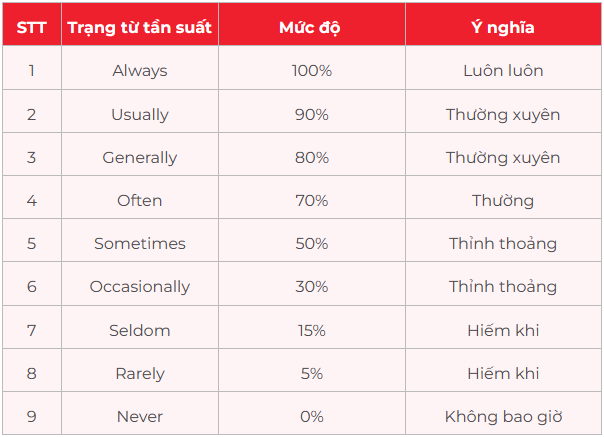Grammar Unit 8 Tiếng Anh 8 Global SuccessI. Adverbs of frequency (Trạng từ chỉ tần suất) 1. Định nghĩa Trạng từ tần suất trong tiếng Anh dùng để mô tả mức độ thường xuyên, tần suất lặp lại của một hành động, sự việc nào đó. Chúng thường xuất hiện trong thì hiện tại đơn để nói về các sự kiện có tính lặp đi lặp lại. 2. Vị trí: 2.1. Đứng trước động từ thường Trạng từ tần suất trong câu khẳng định, phủ định và nghi vấn đều đứng trước động từ thường cũng là động từ chính. 2.2. Đứng sau động từ tobe Trạng từ tần suất trong các câu đều GÓP Ý HAY - NHẬN NGAY QUÀ CHẤT Gửi góp ý cho HocTot.Nam.Name.Vn và nhận về những phần quà hấp dẫn ADVERBS OF FREQUENCY & PRESENT SIMPLE FOR FUTURE EVENTS (Trạng từ tần suất & thì hiện tại đơn cho sự việc tương lai) I. Adverbs of frequency (Trạng từ chỉ tần suất) 1. Định nghĩa Trạng từ tần suất trong tiếng Anh dùng để mô tả mức độ thường xuyên, tần suất lặp lại của một hành động, sự việc nào đó. Chúng thường xuất hiện trong thì hiện tại đơn để nói về các sự kiện có tính lặp đi lặp lại.
2. Vị trí: 2.1. Đứng trước động từ thường Trạng từ tần suất trong câu khẳng định, phủ định và nghi vấn đều đứng trước động từ thường cũng là động từ chính. Công thức: (+) S + adv + V (-) S + don’t/ doesn’t adv + V (?) Do/ Does + S + adv + V…? Ví dụ: My sister usually writes to me because she’s homesick. (Chị gái thường xuyên viết thư cho tôi vì chị ấy nhớ nhà.) 2.2. Đứng sau động từ tobe Trạng từ tần suất trong các câu đều đứng sau động từ tobe. Công thức: (+) S + am/ is/ are + adv + … (-) S + am/ is/ are not + adv + … (?) Am/ Is/ Are + S + adv + … ? Ví dụ: They’re always slower than other teams. (Họ luôn luôn chậm hơn so với những đội khác.) 2.3. Đứng sau trợ động từ Ví dụ: I have never been abroad. (Tôi chưa bao giờ ra nước ngoài.) Lưu ý: Hầu hết các trạng từ tần suất đều có thể đứng đầu câu hoặc cuối câu, ngoại trừ always, hardly, ever và never. Khi đứng đầu câu, chúng có vai trò nhấn mạnh hành động được nhắc tới. Ex: My parents usually remind us to do homework early. (Bố mẹ luôn nhắc chúng tôi làm bài tập về nhà từ sớm.) Sometimes, my husband and I go to the beach on the weekend. (Thi thoảng, tôi và chồng đi đến bãi biển vào cuối tuần.) II. Thì hiện tại đơn chỉ sự việc tương lai Chúng ta sử dụng thì hiện tại đơn với ý nghĩa tương lai để nói về thời khóa biểu hoặc lịch trình. Ví dụ: I have to go now. My art lesson starts at one o’clock. (Tôi phải đi bây giờ. Lớp học vẽ của tôi bắt đầu lúc 1 giờ.) The train leaves at 4:30, so we still have a lot of time. (Tàu hỏa rời đi lúc 4:30, vì vậy chúng tôi vẫn còn nhiều thời gian.)
>> Học trực tuyến lớp 8 trên Tuyensinh247.com. Đầy đủ khoá học các bộ sách: Kết nối tri thức với cuộc sống; Chân trời sáng tạo; Cánh diều. Cam kết giúp học sinh lớp 8 học tốt, hoàn trả học phí nếu học không hiệu quả. PH/HS tham khảo chi tiết khoá học tại: Link
|




















